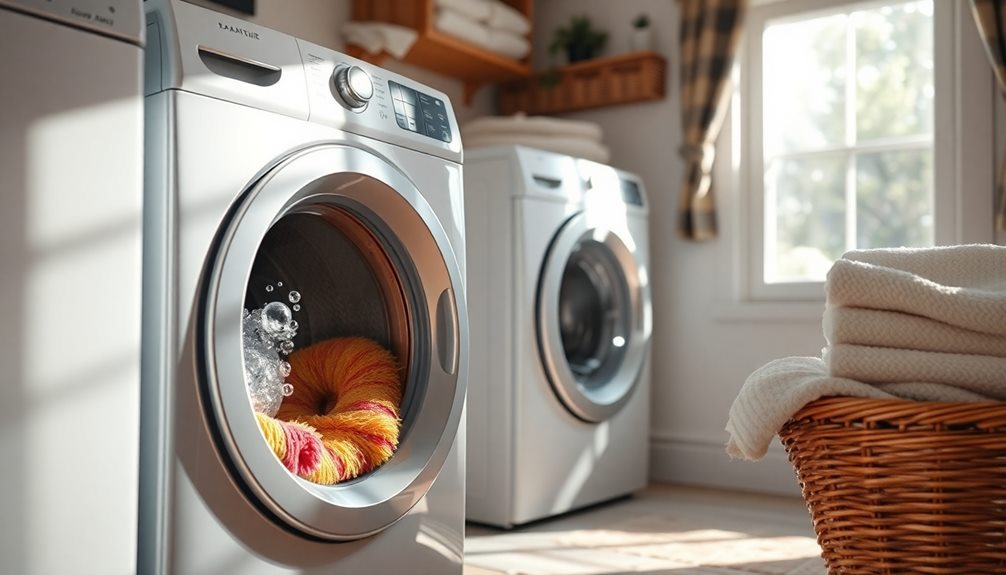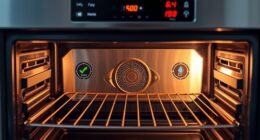Are you interested in cutting costs on your utility bills? You’re in luck! We have put together a list of 12 energy-efficient appliances that can assist in reducing those bothersome expenses.
From refrigerators to dishwashers, washing machines to dryers, we’ve got you covered. Say goodbye to wastefulness and hello to savings! With these appliances, you can enjoy the convenience you crave while being mindful of your energy consumption.
Upgrade your home with these power-saving champions and watch your bills shrink. No more wasted energy or money down the drain. Get ready to master the art of efficiency and take control of your utility costs.
Let’s dive in and discover the power of these energy-saving appliances!

Key Takeaways
- Energy-efficient appliances are available for cleaning, cooling and heating, cooking, air circulation, lighting, and entertainment.
- Energy-efficient dishwashers, washing machines, and dryers can help reduce energy consumption.
- Energy-efficient air conditioners and water heaters are important for cooling and heating purposes.
- Induction stoves and energy-saving stove features are beneficial for cooking while gas stoves have some disadvantages.
Refrigerators
We have found that the most energy-efficient refrigerators can save households up to 50% on their utility bills.
When it comes to maintaining your refrigerator’s energy efficiency, there are a few key steps you can take.
First, make sure to clean the condenser coils regularly. Dust and debris can build up on these coils, causing the refrigerator to work harder and use more energy.
Additionally, keeping the refrigerator well-stocked helps to maintain its temperature more effectively, reducing energy consumption.

Another important factor to consider is the energy-saving features of the refrigerator itself. Look for models with features such as adjustable temperature controls, LED lighting, and automatic defrosting.
These features not only save energy but also contribute to a longer lifespan for your refrigerator.
By investing in regular maintenance and choosing a refrigerator with energy-saving features, you can significantly reduce your utility bills.
Now, let’s move on to the next section about ‘dishwashers’ and explore how they can also help to cut energy costs.

Dishwashers
When it comes to energy-efficient dishwashers, there are a few key points to consider.
Firstly, water-saving dishwasher technology is a great feature to look for, as it can significantly reduce water consumption.
Additionally, opting for Energy-Star rated options ensures that you’re choosing a dishwasher that meets strict energy efficiency guidelines.
Lastly, efficient cleaning cycles that use less water and energy without compromising cleanliness are essential for cutting down utility bills.

Water-Saving Dishwasher Technology
Using water-saving dishwasher technology can significantly reduce our utility bills and conserve water. When it comes to water saving dishwasher features, there are several benefits of energy efficient dishwashers that make them a smart choice for any household:
- Efficient water usage: Energy-efficient dishwashers use less water per cycle, reducing overall water consumption and saving money on water bills.
- High-pressure jets: These dishwashers are equipped with high-pressure jets that effectively remove stubborn food residues, eliminating the need for pre-rinsing and saving water in the process.
- Sensor technology: Energy efficient dishwashers use sensors to detect the level of dirtiness and adjust the water usage accordingly, ensuring optimal cleaning performance while conserving water.
- Eco-friendly detergents: These dishwashers work well with eco-friendly detergents, which not only save water but also reduce the impact on the environment.
- Long-term savings: Investing in an energy-efficient dishwasher may initially be more expensive, but the long-term savings on utility bills make it a cost-effective choice.
Transitioning to the next section, energy-star rated options provide even more energy savings.
Energy-Star Rated Options
How can Energy-Star rated options for dishwashers help us save on utility bills?
Energy-Star rated dishwashers are designed to be more energy efficient, meaning they use less electricity and water compared to conventional models. This translates to lower utility bills and reduced environmental impact.

These dishwashers are equipped with advanced technologies such as sensors that detect soil levels and adjust water and energy usage accordingly. They also have features like delayed start and eco-friendly wash cycles, allowing users to take advantage of off-peak electricity rates and further reduce energy consumption.
Additionally, Energy-Star rated dishwashers often have a high energy efficiency rating, indicating their ability to effectively clean dishes while using minimal resources.
Efficient Cleaning Cycles
To maximize energy savings and optimize cleaning performance, we can explore the efficient cleaning cycles available in dishwashers. These smart appliances offer a range of features that efficiently clean your dishes while reducing energy consumption.
Here are five key benefits of efficient cleaning cycles:

- Quick Wash: This cycle uses less water and energy, perfect for lightly soiled dishes or when you’re in a hurry.
- Eco Mode: Designed to save energy, this cycle extends the cleaning time while using less water and electricity.
- Sensor Wash: This intelligent cycle detects the level of dirtiness and adjusts the water and energy usage accordingly.
- Delay Start: You can set your dishwasher to start at a later time when electricity rates are lower, saving you money.
- Half Load Option: When you have fewer dishes to clean, this option allows you to run a smaller cycle, reducing water and energy waste.
With these efficient cleaning cycles, you can achieve sparkling clean dishes while minimizing your environmental impact and utility bills.
Washing Machines
We have found that with energy-efficient washing machines, our utility bills have significantly decreased. These modern appliances are designed to minimize water usage and reduce energy consumption. By incorporating innovative technologies and advanced features, these washing machines provide efficient cleaning cycles while saving both water and energy.
To better understand the benefits of energy-efficient washing machines, let’s take a look at the following table:
| Energy-Efficient Washing Machines | Benefits |
|---|---|
| Reduced Water Usage | Energy-efficient washing machines use less water per cycle, helping to conserve this precious resource. |
| Lower Energy Consumption | These appliances are designed to use less electricity, resulting in reduced energy consumption and lower utility bills. |
| Advanced Cleaning Technologies | Energy-efficient washing machines incorporate features like sensor technology and variable speed motors, ensuring effective cleaning while optimizing energy usage. |
| Environmentally Friendly | By minimizing water and energy consumption, these appliances help to reduce our carbon footprint and contribute to a more sustainable future. |
As we can see, energy-efficient washing machines offer a range of benefits, from reducing water usage to lowering energy consumption. These appliances not only save money but also contribute to environmental conservation. Now let’s move on to the next section and learn about energy-efficient dryers.

Dryers
Now let’s talk about how dryers can contribute to reducing our utility bills with energy-efficient features.
When it comes to dryer maintenance, there are a few key things to keep in mind. First, clean the lint filter after every load to improve airflow and reduce drying time. Second, regularly inspect and clean the venting system to prevent blockages and ensure optimal performance. Third, avoid overloading the dryer as it can lead to longer drying cycles and unnecessary energy consumption.
Now, let’s explore some energy-saving dryer settings that can help us save money and reduce our carbon footprint:
- Opt for the moisture sensor setting, which automatically stops the dryer once the clothes are dry. This prevents unnecessary energy usage.
- Consider using the low heat or air-dry setting for items that don’t require high heat, such as delicate fabrics or items that are already partially dry.
- Use the timed dry setting sparingly and only when necessary. This setting allows you to set a specific drying time, but it may result in over-drying and energy wastage if not used judiciously.
- When possible, line dry your clothes outdoors instead of using the dryer. It’s a free and energy-efficient way to dry your clothes while enjoying the fresh air.
- Finally, remember to clean the dryer’s exhaust duct regularly to ensure efficient airflow and prevent lint buildup, which can pose a fire hazard.
Air Conditioners
Continuing our exploration of energy-saving appliances that reduce utility bills, let’s now turn our attention to air conditioners and their impact on energy consumption. When it comes to air conditioning, proper maintenance is crucial to ensure optimal energy efficiency. Regularly cleaning or replacing air filters, checking and sealing ducts for leaks, and scheduling professional inspections can significantly improve the efficiency of your air conditioner.

To give you a better understanding of the energy efficiency of different air conditioner models, here is a comparison table showcasing three popular options:
| Air Conditioner Model | Cooling Capacity (BTU) | Energy Efficiency Ratio (EER) |
|---|---|---|
| Model A | 12,000 | 12.5 |
| Model B | 14,000 | 15.2 |
| Model C | 18,000 | 16.8 |
As you can see, higher EER values indicate better energy efficiency, meaning that Model C is the most energy-efficient option among the three.
Additionally, advancements in cooling technology have led to the development of energy-efficient air conditioners. These models use features like smart thermostat controls, variable speed compressors, and improved insulation to minimize energy consumption without compromising on performance. By investing in energy-efficient cooling technology and ensuring proper air conditioning maintenance, you can effectively reduce your utility bills while staying comfortable during hot summer months.
Water Heaters
To maximize energy efficiency, it’s important to regularly maintain water heaters by draining and flushing them at least once a year. By doing so, you can ensure that your water heater operates at its peak efficiency, saving you money on your utility bills.

Additionally, consider the following tips to further improve water heater efficiency:
- Insulate your water heater tank to reduce heat loss.
- Set the temperature of your water heater to 120 degrees Fahrenheit to avoid unnecessary energy consumption.
- Install low-flow showerheads and faucets to reduce water usage and the amount of hot water needed.
- Consider upgrading to a tankless water heater, which heats water on demand and eliminates the need for a storage tank.
- Regularly check for leaks and repair them promptly to prevent wasted water and energy.
Tankless water heaters are particularly efficient because they only heat water when it’s needed, eliminating standby heat loss that occurs with traditional storage tank water heaters. With their compact size and long lifespan, tankless water heaters provide an energy-efficient solution for your hot water needs.
Ovens
Ovens play a crucial role in our daily cooking routines, making them a key area to focus on when it comes to energy efficiency. Two types of energy-efficient ovens that can help reduce utility bills are induction cooking ovens and convection ovens.
Induction cooking ovens use electromagnetic fields to directly heat the cookware, resulting in faster cooking times and higher energy efficiency compared to traditional electric or gas ovens. The heat is generated only in the cookware itself, ensuring minimal energy waste. Additionally, induction cooking ovens provide precise temperature control, allowing for more accurate cooking.

Convection ovens, on the other hand, circulate hot air inside the oven using fans. This constant airflow ensures even heat distribution, reducing cooking time and energy consumption. The ability to cook at lower temperatures and for shorter durations further contributes to energy savings.
When choosing an energy-efficient oven, look for models with good insulation to minimize heat loss. Opt for ovens with energy-saving features such as programmable timers, which allow you to set cooking times and automatically turn off the oven when the food is done.
Stoves
When it comes to stoves, there are two main options to consider: induction and gas stoves.
Induction stoves are known for their energy efficiency, as they use electromagnetic fields to directly heat the cookware, making them faster and more precise.

On the other hand, gas stoves offer precise temperature control and are often favored by professional chefs.
Additionally, both types of stoves can feature energy-saving functions such as timers and heat sensors, which help reduce energy consumption and lower utility bills.
Induction Vs Gas Stoves
In our search for energy-efficient appliances, we compared induction stoves to gas stoves. Here are the benefits of induction stoves and the disadvantages of gas stoves:
- Induction benefits:
- Energy efficient: Induction stoves use electromagnetic fields to heat the cookware directly, resulting in less wasted energy.
- Faster cooking: Induction stoves heat up quickly, reducing cooking time.
- Precise temperature control: Induction stoves offer precise and instant temperature adjustments, allowing for more control over the cooking process.
- Safety features: Induction stoves only heat the cookware, not the surrounding surface, making them safer to use.
- Easy to clean: Since induction stoves have a smooth glass surface, they’re easy to wipe clean.
- Gas disadvantages:
- Less energy efficient: Gas stoves lose heat to the surrounding environment, resulting in wasted energy.
- Slower heating: Gas stoves take longer to heat up compared to induction stoves.
- Less precise temperature control: Gas stoves have less precise temperature control compared to induction stoves.
- Safety hazards: Gas stoves pose a risk of gas leaks and open flames.
- More difficult to clean: Gas stoves have more nooks and crannies, making them harder to clean.
Choosing an energy-efficient appliance like an induction stove can’t only save you money on utility bills but also provide you with greater cooking efficiency and safety.

Energy-Saving Stove Features
One feature that can significantly decrease energy usage in our stoves is opting for models with energy-saving settings. These energy-saving stove designs are designed to maximize efficiency and minimize energy waste, helping us to save on our utility bills. One popular type of energy-saving stove is the induction stove, which uses electromagnetic fields to directly heat the cookware, rather than heating the entire stove surface. This not only reduces energy waste but also allows for precise temperature control and faster cooking times. Induction stoves also have the added benefit of being safer, as they do not emit an open flame or hot surface. By choosing energy-saving stove features like induction technology, we can enjoy the benefits of lower energy consumption, reduced utility bills, and a more sustainable lifestyle.
| Energy-Saving Stove Features | Benefits |
|---|---|
| Induction technology | Lower energy consumption |
| Precise temperature control | Reduced utility bills |
| Faster cooking times | More sustainable lifestyle |
Microwaves
We found that upgrading our microwave to an energy-efficient model significantly reduced our utility bills. Not only did it help us save money, but it also offered several other benefits.
Here are some microwave safety tips and cooking tips that can help you make the most of your energy-efficient microwave:
- Keep it clean: Regularly clean your microwave to remove any food particles or spills that can cause it to work harder and use more energy.
- Use microwave-safe containers: Ensure that the containers you use are labeled as microwave-safe to prevent any accidents or damage to the microwave.
- Cover your food: Covering your food while microwaving helps to trap the steam and cook the food more efficiently.
- Utilize the power levels: Adjusting the power levels on your microwave can help you cook different types of food more evenly and conserve energy.
- Use the timer wisely: Set the timer accurately to avoid overcooking or undercooking your food, which can result in unnecessary energy consumption.
By following these tips, you can ensure the safety of your microwave and optimize its energy efficiency.

Now, let’s move on to another energy-saving appliance, fans, which can help you reduce your energy consumption even further.
Fans
Fans are a great way to cool down while saving energy, and there are two main types to consider: ceiling fans and floor fans.
Ceiling fans are ideal for circulating air in larger rooms and can help reduce the reliance on air conditioning.
On the other hand, floor fans are more portable and can be moved around to provide a targeted cooling effect.

When choosing a fan, look for energy-saving features like adjustable speed settings and timers.
Some of the best fan brands known for their energy efficiency include Dyson, Honeywell, and Lasko.
Ceiling Vs. Floor Fans
The energy-efficient appliances that can significantly reduce utility bills include both ceiling fans and floor fans. When it comes to choosing between the two, it’s essential to consider the specific benefits and advantages they offer.
Here are the key points to keep in mind:

- Ceiling fan benefits:
- Efficiently circulates air throughout the room, providing a consistent and cooling airflow.
- Helps to distribute warm air during the winter months, improving heating efficiency.
- Saves space and keeps the floor clear for other furniture or activities.
- Offers various styles and designs to complement any room decor.
- Operates quietly, ensuring a peaceful environment.
- Floor fan advantages:
- Provides targeted cooling in specific areas, making it ideal for personal use.
- Easy to move around and adjust according to individual preferences.
- Can be used outdoors or in rooms without a ceiling fixture.
- Offers versatility with adjustable speeds and oscillating features.
- Provides instant relief from heat, making it perfect for immediate cooling needs.
Considering these factors, it’s important to choose the fan that best suits your needs and preferences.
Now, let’s delve into the energy-saving fan features that can further enhance efficiency and reduce utility costs.
Energy-Saving Fan Features
When considering energy-saving fan features, it’s important to look for options that maximize efficiency and reduce utility costs. Energy saving fan designs are specifically engineered to consume less electricity while providing optimal performance. These designs often include features such as improved blade design, efficient motors, and enhanced airflow technology.
Additionally, fan speed control technology allows users to adjust the speed of the fan according to their needs, further reducing energy consumption. By utilizing these energy-saving fan features, homeowners can significantly lower their utility bills without compromising on comfort.

Now that we’ve discussed the importance of energy-saving fan features, let’s move on to the next section where we’ll explore the best fan brands that offer these innovative features.
Best Fan Brands
After considering energy-saving fan features, we can now explore the top brands that offer these innovative options.
When it comes to the best tower fans, there are a few brands that stand out from the rest:
- Dyson: Known for their sleek design and powerful airflow, Dyson tower fans are a popular choice among consumers.
- Lasko: Lasko tower fans are known for their affordability without compromising on performance and energy efficiency.
- Honeywell: Honeywell offers a range of tower fans with features like oscillation and remote control, making them convenient and efficient.
- Vornado: Vornado tower fans are praised for their vortex technology, which circulates air effectively and quietly.
- Ozeri: Ozeri tower fans are known for their modern design and energy-saving features, making them both stylish and efficient.
When it comes to energy-efficient ceiling fans, brands like Hunter, Emerson, and Haiku are highly recommended. These brands offer a range of models that prioritize energy efficiency without sacrificing style or performance.

With these top brands, you can enjoy a cool and comfortable home while reducing your energy consumption and utility bills.
Light Bulbs
Switching to energy-efficient light bulbs can significantly reduce electricity consumption and lower utility bills. LED light bulbs are a prime example of energy-saving lighting technology that can help homeowners save money while also reducing their carbon footprint.
LED, or light-emitting diode, bulbs are more efficient than traditional incandescent bulbs because they convert more energy into light rather than heat. This means that they use less electricity to produce the same amount of light. In fact, LED bulbs can use up to 80% less energy than incandescent bulbs, resulting in substantial savings on electricity bills.
Not only do LED bulbs consume less electricity, but they also have a longer lifespan compared to traditional bulbs. While incandescent bulbs typically last around 1,000 hours, LED bulbs can last up to 25,000 hours or more. This means that homeowners won’t only save money on their energy bills but also on the cost of replacing bulbs frequently.

Additionally, LED bulbs are available in a variety of colors and brightness levels, allowing homeowners to customize their lighting preferences. They’re also mercury-free, making them safer for both the environment and human health.
Televisions
As we transition to discussing televisions, let’s delve into the energy-efficient options available in the market today.
When it comes to televisions, there are several energy-efficient models to choose from that can help reduce your electricity consumption and lower your utility bills.
Here are some key features to look for in energy-efficient televisions:

- Energy-saving features: Many televisions now come with built-in energy-saving features such as automatic brightness adjustment and power-saving modes. These features help optimize energy usage and reduce electricity consumption.
- Smart TVs: Smart TVs aren’t only convenient for streaming your favorite shows and movies, but they also tend to be more energy-efficient compared to traditional televisions. Smart TVs are designed to consume less power when in standby mode and often have energy-saving options.
- LED technology: LED televisions are known for their energy efficiency. These TVs use light-emitting diodes (LEDs) to illuminate the screen, consuming less energy compared to older LCD models.
- Energy Star certified: Look for televisions that are Energy Star certified. This certification ensures that the TV meets strict energy efficiency guidelines set by the Environmental Protection Agency (EPA).
- Power consumption ratings: Pay attention to the power consumption ratings provided by the manufacturer. Look for televisions with lower power consumption ratings, as they’ll use less energy and save you money in the long run.
Frequently Asked Questions
Are There Any Energy-Efficient Refrigerators That Also Have Advanced Cooling Features?
Yes, there are energy-efficient refrigerators available that also have advanced cooling features. These appliances, with smart technology, use less energy while still providing optimal cooling performance.
Additionally, some energy-efficient refrigerators come with adjustable temperature settings, allowing users to customize the cooling levels according to their needs.
How Long Does a Typical Energy-Efficient Dishwasher Cycle Last?
When it comes to energy-efficient dishwasher maintenance, one key factor to consider is the length of the dishwasher cycle. Compared to regular dishwashers, energy-efficient models are designed to use less water and energy, which can result in longer cycle times.
However, the exact duration of a typical energy-efficient dishwasher cycle can vary depending on the specific model and settings chosen. It’s important to consult the manufacturer’s instructions or product specifications for accurate information on cycle times.

Can Energy-Efficient Washing Machines Accommodate Larger Loads Without Compromising Their Efficiency?
Yes, energy-efficient washing machines can accommodate larger loads without compromising their efficiency. These machines are designed with a larger capacity to handle more laundry in a single cycle.
They also have advanced water-saving features that ensure optimal water usage, even with larger loads. This means you can wash more clothes while still saving water and energy.
Energy-efficient washing machines are a great choice for those looking to maximize their laundry efficiency while reducing their environmental impact.
What Are the Benefits of Using Energy-Efficient Dryers Compared to Conventional Ones?
Using energy-efficient dryers instead of conventional ones offers numerous benefits.

Firstly, these appliances can reduce your energy consumption by up to 50%, resulting in significant savings on your utility bills.
Additionally, energy-efficient dryers are designed to dry clothes more efficiently, which means shorter drying cycles and less wear and tear on your garments.
Lastly, these dryers often come with advanced features such as moisture sensors and adjustable settings, allowing you to customize the drying process to meet your needs.
Are There Any Energy-Efficient Air Conditioners That Can Provide Both Cooling and Heating Functions?
Yes, there are energy-efficient air conditioners that can provide both cooling and heating functions. These air conditioners are designed to be energy-efficient and are suitable for small spaces as well as commercial use.

By using advanced technology and smart features, these appliances can effectively regulate the temperature while minimizing energy consumption.
Investing in energy-efficient air conditioners not only helps reduce utility bills but also contributes to a more sustainable and eco-friendly lifestyle.
How Can I Choose Energy-Efficient Appliances to Save on Utility Bills?
When it comes to choosing appliances, it’s essential to consider factors for energy efficiency. Look for the Energy Star label, check the appliance’s energy guide label, compare the energy consumption of different models, and consider the size and features that can affect energy usage. All these factors can help you save on utility bills.
Conclusion
When it comes to saving energy and cutting down utility bills, these 12 appliances are our knights in shining armor.
Like loyal companions, they work tirelessly to keep our homes efficient and our wallets happy.

From the reliable refrigerators to the hardworking washing machines, each appliance plays its part in the battle against wasted energy.
So let’s embrace these energy-efficient superheroes and reap the rewards of lower utility bills and a greener planet.










